STIHL FS 550, FS 500 Owner's Manual
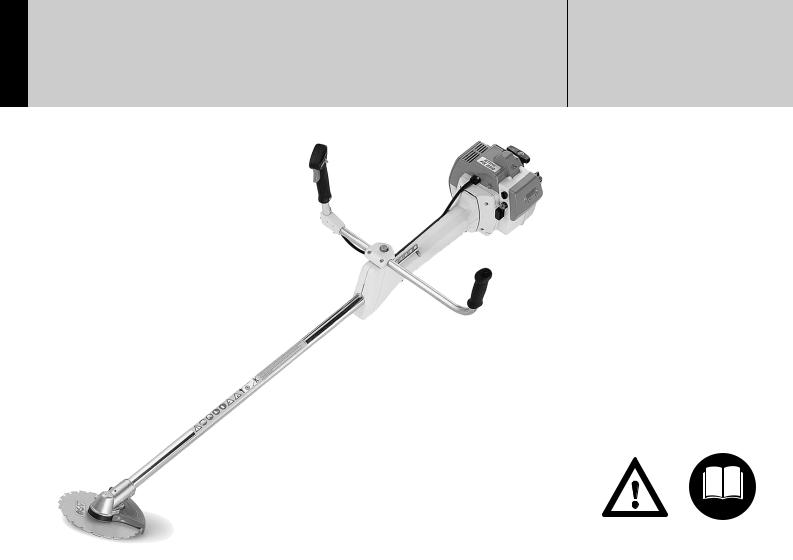
STIH)
STIHL FS 500, 550
Instruction Manual Manual de instrucciones
Warning!
Read and follow all safety precautions in Instruction Manual – improper use can cause serious or fatal injury.
Advertencia!
Lea y siga todas las precauciones de seguridad dadas en el manual de instrucciones – el uso incorrecto puede causar lesiones graves o mortales.
Contents
09.fm |
|
Guide to Using this Manual .............. |
2 |
|
|
Safety Precautions and |
|
||
01_ |
|
Working Techniques |
3 |
|
004_ |
|
|||
|
Mounting the Bike Handle .............. |
17 |
||
_ |
|
Adjusting the Throttle Cable |
18 |
|
082 |
|
|||
|
Approved Combinations of |
|
||
SE |
|
|
||
|
Cutting Tool and Deflector |
19 |
||
BA_ |
|
|||
|
Mounting the Cutting Tools |
20 |
||
|
|
|||
|
|
Fuel ................................................ |
23 |
|
|
|
Fueling ............................................ |
24 |
|
|
|
Fitting the Harness ......................... |
25 |
|
|
recycled. |
Balancing the Machine ................... |
26 |
|
|
Starting / Stopping the Engine |
26 |
||
|
|
|||
|
|
Operating Instructions .................... |
28 |
|
|
can be |
Cleaning the Air Filter ..................... |
29 |
|
|
Motor Management ........................ |
29 |
||
|
paper |
Adjusting the Carburetor ................ |
30 |
|
|
Spark Arresting Screen in Muffler |
31 |
||
|
oils; |
|||
|
Winter Operation ............................ |
32 |
||
paper.free-chlorineon vegetablecontaininks |
Checking the Spark Plug |
32 |
||
|
|
|||
|
|
Replacing the Starter Rope |
|
|
|
|
and Rewind Spring ......................... |
33 |
|
|
|
Storing the Machine ........................ |
35 |
|
|
|
Sharpening Metal Cutting Tools ...... |
35 |
|
Printed |
Printing |
Maintenance Chart ......................... |
37 |
|
Parts and Controls |
38 |
|||
|
|
|||
|
|
Specifications ................................. |
40 |
|
|
|
Special Accessories ....................... |
40 |
|
|
Germany |
Maintenance and Repairs ............... |
41 |
|
|
STIHL Incorporated Federal |
|
||
|
|
|
||
2008KG, |
Printedin |
Emission Control |
|
|
Warranty Statement |
42 |
|||
|
|
|||
© ANDREAS STIHL AG & Co. |
0458 398 8621. M0,4. K8. Rei. |
STIHl |
|
|
English / USA
Allow only persons who understand this manual to operate your clearing saw.
To receive maximum performance and satisfaction from your STIHL brushcutter, it is important that you read and understand the maintenance and safety precautions, starting on page 3, before using your clearing saw.
Contact your STIHL dealer or the STIHL distributor for your area if you do not understand any of the instructions in this manual.
!Warning!
Because a clearing saw is a high-speed cutting tool some special safety precautions must be observed to reduce the risk of personal injury.
Careless or improper use may cause serious or even fatal injury. Make sure your unit is equipped with the proper deflector, handle and harness for the type of cutting attachment being used. Always wear proper eye protection.
STIHL's philosophy is to continually improve all of its products. As a result, engineering changes and improvements are made from time to time. If the operating characteristics or the appearance of your clearing saw differs from those described in this manual, please contact your STIHL dealer for information and assistance.
FS 500, FS 550 |
1 |
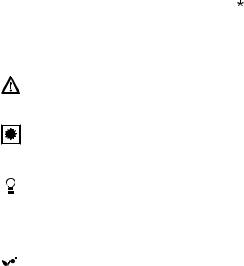
English / USA
Guide to Using this Manual
Pictograms
All the pictograms attached to the machine are shown and explained in this manual.
The operating and handling instructions are supported by illustrations.
Symbols in text
The individual steps or procedures described in the manual may be marked in different ways:
:A bullet marks a step or procedure without direct reference to an illustration.
A description of a step or procedure that refers directly to an illustration may contain item numbers that appear in the illustration.
Example:
Loosen the screw (1) Lever (2) ...
In addition to the operating instructions, this manual may contain paragraphs that require your special attention. Such paragraphs are marked with the symbols described below:
Warning where there is a risk of an accident or personal injury or
serious damage to property.
 Caution where there is a risk of damaging the machine or its individual components.
Caution where there is a risk of damaging the machine or its individual components.


 Note or hint which is not essential for using the machine, but may improve the operator’s understanding of the situation and result in better use of the machine.
Note or hint which is not essential for using the machine, but may improve the operator’s understanding of the situation and result in better use of the machine.

 Note or hint on correct procedure in
Note or hint on correct procedure in  order to avoid damage to the environment.
order to avoid damage to the environment.
Equipment and features
This instruction manual may refer to several models with different features. Components that are not installed on all models and related applications are marked with an asterisk (*). Such components may be available as special accessories from your STIHL dealer.
Engineering improvements
STIHL’s philosophy is to continually improve all of its products. As a result, engineering changes and improvements are made from time to time. If the operating characteristics or the appearance of your machine differ from those described in this manual, please contact your STIHL dealer for assistance.
Therefore some changes, modifications and improvements may not be covered in this manual.
2 |
FS 500, FS 550 |

English / USA
Safety Precautions and
Working Techniques
Warning!
Because a clearing saw is a high-speed, fast-cutting power tool, special safety
precautions must be observed to reduce the risk of personal injury.
It is important that you read, fully understand and observe the following safety precautions and warnings. Read the owner's manual and the
safety instructions periodically. Careless or improper use of any clearing saw may cause serious or fatal injury.
Have your STIHL dealer show you how to operate your clearing saw. Observe all applicable local safety regulations, standards and ordinances.
!Warning!
Do not lend or rent your clearing saw without the owner's manual. Be sure that anyone using your clearing saw understands the information contained in this manual.
!Warning!
The use of any clearing saw may be hazardous. If the rotating cutting tool comes in contact with your body, it will cut you. When it comes in contact with solid foreign objects such as rocks or bits of metal, it may fling them directly or by ricochet in the direction of bystanders or the operator.
Striking such objects could damage the cutting attachment and may cause blades to crack, chip or break.
STIHL does not recommend the use of rigid blades when cutting in stony areas. Thrown objects or damaged blades may result in serious or fatal injury to the operator or bystanders.
!Warning!
Minors should never be allowed to use a clearing saw. Bystanders, especially children, and animals should not be allowed in the area where a clearing saw is in use.
Never let the clearing saw run unattended.
Most of these safety precautions and warnings apply to the use of all STIHL clearing saws. Different models may have different parts and controls. See the appropriate section of your owner's manual for a description of the controls and function of the parts of your model clearing saw.
Safe use of a clearing saw involves
1.the operator
2.the clearing saw
3.the use of the clearing saw.
THE OPERATOR
Physical Condition
You must be in good physical condition and mental health and not under the influence of any substance (drugs, alcohol, etc.) which might impair vision, dexterity or judgement. Do not operate a clearing saw when you are fatigued.
Be alert – if you get tired while operating your clearing saw, take a break. Tiredness may result in loss of control. Working with any clearing saw can be strenuous. If you have any condition that might be aggravated by strenuous work, check with your doctor before operating a clearing saw.
FS 500, FS 550 |
3 |
English / USA
!Warning!
Prolonged use of a clearing saw (or other machines) exposing the operator to vibrations may produce whitefinger disease (Raynaud's phenomenon) or carpal tunnel syndrome.
These conditions reduce the hand's ability to feel and regulate temperature, produce numbness and burning sensations and may cause nerve and circulation damage and tissue necrosis.
All factors which contribute to whitefinger disease are not known, but cold weather, smoking and diseases or physical conditions that affect blood vessels and blood transport, as well as high vibration levels and long periods of exposure to vibration are mentioned as factors in the development of whitefinger disease. In order to reduce the risk of whitefinger disease and carpal tunnel syndrome, please note the following:
–Most STIHL power tools are available with an anti-vibration ("AV") system designed to reduce the transmission of vibrations created by the engine to the operator's hands. An AV system is recommended for those persons using power tools on a regular or sustained basis.
–Wear gloves and keep your hands warm.
–Keep the AV system well maintained. A clearing saw with loose components or with damaged or worn AV buffers will tend to have higher vibration levels.
–Maintain a firm grip at all times, but do not squeeze the handles with constant, excessive pressures and take frequent breaks.
All the above mentioned precautions do not guarantee that you will not sustain whitefinger disease or carpal tunnel syndrome. Therefore continual and regular users should monitor closely the condition of their hands and fingers. If any of the above symptoms appear, seek medical advice immediately.
!Warning!
The ignition system of your unit produces an electromagnetic field of a very low intensity. This field may interfere with some pacemakers. To reduce the risk of serious or fatal injury, persons with pacemaker should consult their physician and the pacemaker manufacturer before operating this tool.
Proper Clothing
!Warning!
To reduce the risk of injury, the operator should wear proper protective apparel. The deflector provided with your clearing saw may not protect the operator from all foreign objects (gravel, glass, wire, etc.) thrown by the rotating cutting attachment. Thrown objects may also ricochet and strike the operator.
4 |
FS 500, FS 550 |
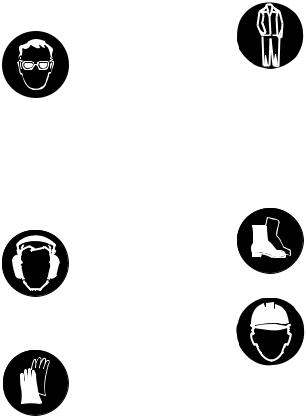
English / USA
!Warning!
To reduce the risk of injury to your eyes never
operate a clearing saw unless wearing goggles or properly fitted safety glasses with adequate top
and side protection complying with ANSI Z 87.1 (or your applicable national standard). To reduce the risk of injury to your face STIHL recommends that you also wear a face shield or face screen over your goggles or safety glasses.
!Warning!
Clearing saw noise may damage your hearing.
Wear sound barriers (ear plugs or ear mufflers) to
protect your hearing. Continual and regular
users should have their hearing checked regularly.
Protect your hands with gloves when handling the clearing saw and the cutting tool. Heavy-duty, nonslip gloves improve your grip and protect your hands.
Clothing must be sturdy and snug-fitting, but allow
complete freedom of movement. Avoid loose-
fitting jackets, scarfs, neckties, jewelry, flared or
cuffed pants, unconfined longhair or anything that could become caught on branches, brush or moving parts of the unit. Wear long pants made of heavy material to protect your legs. Do not wear shorts, pants, sandals or go bare foot. Secure hair so it is above shoulder level.
Good footing is most important in clearing saw work. Wear sturdy boots
with nonslip soles. Steeltoed safety boots are recommended.
Wear an approved safety hard hat to reduce the risk of injury to your head when there is a danger of head injuries.
THE CLEARING SAW
For illustrations and definitions of the clearing saw parts see the chapter on "Parts and Controls".
!Warning!
Never modify a clearing saw in any way. Only attachments supplied by STIHL or expressly approved by STIHL for use with the specific STIHL clearing saw models are authorized. Although certain unauthorized attachments are useable for the STIHL clearing saw, their use may, in fact, be extremely dangerous.
FS 500, FS 550 |
5 |
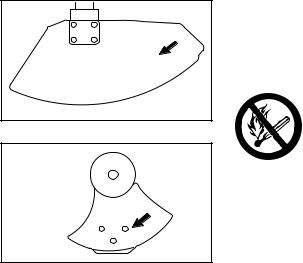
English / USA
THE USE OF THE
CLEARING SAW
Transporting the clearing saw
!Warning!
Always turn off the engine and make sure the cutting attachment has stopped before putting a clearing saw down. When transporting your clearing saw in a vehicle, properly secure it to prevent turnover, fuel spillage and damage to the clearing saw. Keep metal cutting tools covered with the transport guard (optional accessory).
Preparation for the use of the clearing saw
Adjust carrying harness and hand grip to suit your size before starting work. The machine should be properly balanced as specified in your owner's manual for proper control and less fatigue in operation.
Always check your clearing saw for proper condition and operation before starting, particularly the throttle trigger, throttle trigger interlock (if applicable), stopswitch, cutting tool, deflector and harness.
A
000BA006 KN
B
000BA007 KN
Arrows on the deflector (A) and stop (B) show the correct direction of rotation of the cutting tool.
The throttle trigger must move freely and always spring back to the idle position. The cutting tool must be properly tightened and in safe operating condition. Inspect for loose parts (nuts, screws, etc.) and for cracked, bent, warped or damaged blades.
Fueling
Your STIHL clearing saw uses an oilgasoline mixture for fuel (see the chapter on "Fuel" of your owner's manual).
!Warning!
Gasoline is an extremely flammable fuel. If spilled and ignited by a spark or
other ignition source, it can cause fire and serious burn injury or property
damage. Use extreme caution when handling gasoline or fuel mix.
Do not smoke or bring any fire or flame near the fuel or clearing saw.
Fueling Instructions
!Warning!
Fuel your clearing saw in well-ventilated areas, outdoors. Always shut off the engine and allow it to cool before refueling. Gasoline vapor pressure may build up inside the fuel tank depending on the fuel used, the weather conditions and the tank venting system.
6 |
FS 500, FS 550 |

English / USA
In order to reduce the risk of burns and other personal injury from escaping gas vapor and fumes, remove the fuel filler cap on your clearing saw carefully so as to allow any pressure build-up in the tank to release slowly. Never remove fuel filler cap while engine is running.
Select bare ground for fueling and move at least 10 feet (3 m) from the fueling spot before starting the engine. Wipe off any spilled fuel before starting your clearing saw and check for leakage.
!Warning!
Check for fuel leakage while refueling and during operation. If fuel or oil leakage is found, do not start or run the engine until leak is fixed and spilled fuel has been wiped away. Take care not to get fuel on your clothing. If this happens, change your clothing immediately.
Different models may be equipped with different fuel caps.
Cap with Grip
!Warning!
In order to reduce the risk of fuel spillage and fire from an improperly tightened fuel cap, correctly position and tighten the fuel cap in the fuel tank opening.
To do this with this STIHL
cap, raise the grip on the
top of the cap until it is
upright at a 90° angle. Insert the cap in the fuel tank opening with the
triangular marks on the grip of the cap and on the fuel tank opening lining up. Using the grip, turn the cap firmly clockwise as far as it will go (approx. a quarter turn).
Fold the grip flush with the top of the cap. If the grip
does not lie completely flush with the cap and the detent on the grip does not fit in the
corresponding recess in the filler neck, the cap is not properly seated and tightened and you must repeat the above steps.
Screw Cap
!Warning!
Unit vibrations can cause an improperly tightened
fuel filler cap to loosen or
come off and spill
 quantities of fuel. In order to reduce the risk of fuel spillage and fire, tighten the fuel filler cap
quantities of fuel. In order to reduce the risk of fuel spillage and fire, tighten the fuel filler cap
by hand with as much force as possible.
Operating instructions
!Warning!
Improper use of any clearing saw
can cause serious or fatal personal injury. To reduce
the risk of personal injury to the operator from blade contact and thrown objects, make sure your unit is equipped with the proper deflector, handle and harness for the type of cutting attachment being used (see chart in chapters on Approved Combinations of Cutting Tool, Deflector, Handle and Harness).
FS 500, FS 550 |
7 |

English / USA
Keep the deflector (and the skirt where appropriate) adjusted properly at all times (see chapter on mounting the various cutting tools of your owner's manual).
Starting
!Warning!
Your clearing saw is a one-person machine. Once started, it may fling foreign objects for a great distance.
 15m (50ft)
15m (50ft)
To reduce the risk of eye and other injury insure that bystanders are at least
50 feet (15 m) away. Bystanders should be encouraged to wear eye protection. Stop the engine and cutting tool immediately if you are approached. Start and operate your clearing saw without assistance. For specific starting instructions, see the appropriate section of your manual. Place the clearing saw on firm ground or other solid surface in an open area. Maintain a good balance and secure footing.
!Warning!
To reduce the risk of injury from loss of control, be absolutely sure that the cutting tool is clear of you and all other obstructions and objects, including the ground, because when the engine starts at starting-throttle, engine speed will be fast enough for the clutch to engage and turn the cutting tool.
!Warning!
When you pull the starter grip, don't wrap the starter rope around your hand. Do not allow the grip to snap back, but guide the starter rope to rewind it properly. Failure to follow this procedure may result in injury to hand or fingers and may damage the starter mechanism.
With the engine running but at idle, attach the clearing saw to the spring hook of your harness (see appropriate chapter of this manual).
Catalytic converter
!Warning!
Some STIHL clearing saw models are equipped with a catalytic converter, which is designed to reduce the exhaust emissions of the engine
by a chemical process in the muffler. Due to this process, the muffler does not cool down as rapidly as conventional mufflers when the engine returns to idle or is shut off. To reduce the risk of fire and burn injuries, the following specific safety precautions must be observed.
!Warning!
Since a muffler with a catalytic converter cools down less rapidly than conventional mufflers, always set your clearing saw down in the upright position and never locate it where the muffler is near dry brush, grass, wood chips or other combustible materials while it is still hot.
8 |
FS 500, FS 550 |

English / USA
Let the engine cool down sitting on concrete, metal, bare ground or solid wood (e.g. the trunk of a felled tree) away from any combustible substances.
!Warning!
To reduce the risk of fire or burn injury, let the unit cool down before refueling your clearing saw after use.
!Warning!
Never disassemble or modify your muffler. The muffler could be damaged and cause an increase in heat radiation or sparks, thereby increasing the risk of fire or burn injury. You may also permanently damage the engine. Have your muffler serviced and repaired by your STIHL Servicing Dealer only.
!Warning!
To reduce the risk of fire or burn injury, keep the area around the muffler clean. Remove all debris such as pine needles, branches or leaves.
!Warning!
An improperly mounted or damaged cylinder housing or a damaged/ deformed muffler shell may interfere with the cooling effect of the catalytic converter. To reduce the risk of fire or burn injury, do not continue work with a damaged or improperly mounted cylinder housing or a damaged/ deformed muffler shell. Your catalytic converter is furnished with screens designed to reduce the risk of fire from the emission of hot particles. Due to the heat from the catalytic reaction, these screens will normally stay clean and need no service or maintenance. If you experience loss of performance and you suspect a clogged screen, have your muffler maintained by a STIHL Servicing Dealer.
Working Conditions
Operate and start your clearing saw only outdoors in a ventilated area.
Operate the clearing saw under good visibility and daylight conditions only. Work carefully.
!Warning!
Your clearing saw produces toxic exhaust
fumes as soon as the engine is running. These gases (e.g. carbon monoxide) may be
colorless and odorless. To reduce the risk of serious or fatal injury from inhaling toxic fumes, never run the clearing saw indoors or in poorly ventilated locations.
!Warning!
Use of this product can generate dust and fumes containing chemicals known to cause respiratory disease, cancer, birth defects, or other reproductive harm. If you are unfamiliar with the risks associated with the particular dust or fume at issue, consult your employer, governmental agencies such as OSHA and NIOSH and other sources on hazardous materials.
FS 500, FS 550 |
9 |
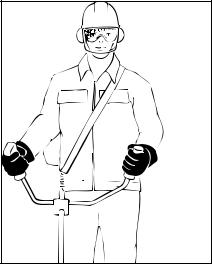
English / USA
California and some other authorities, for instance, have published lists of substances known to cause cancer, reproductive toxicity, etc.
Control dust and fumes at the source where possible. In this regard use good work practices and follow the recommendations of OSHA/NIOSH and occupational and trade associations. When the inhalation of toxic dust and fumes cannot be eliminated, the operator and any bystanders should always wear a respirator approved by NIOSH/MSHA for the type of dust and / or fumes encountered.
!Warning!
The muffler and other parts of the engine (e.g. fins of the cylinder, spark plug) become hot during operation and remain hot for a while after stopping the engine. To reduce risk of burns do not touch the muffler and other parts while they are hot.
Do not cut any material other than grass, brush and wood. The cutting tools may be used only for the operations described in your manual.
000BA014
Always hold the clearing saw firmly with both hands. Wrap your fingers tightly around the handles, keeping the handles cradled between your thumb and forefinger. Keep your hands in this position to have your clearing saw under control at all times. Make sure your clearing saw handles and grip are in good condition and free of moisture, pitch, oil or grease.
!Warning!
Never attempt to operate any clearingsaw with one hand. Loss of control of the clearing saw resulting in serious or fatal injury may result.
!Warning!
Do not overreach. Keep proper footing and balance at all times. Special care must be taken in slippery conditions (wet ground, snow) and in difficult, overgrown terrain. Watch for hidden obstacles such as tree stumps, roots and ditches to avoid stumbling. Be extremely cautious when working on slopes or uneven ground.
10 |
FS 500, FS 550 |

English / USA
!Warning!
Before cutting, inspect the area for stones, glass, pieces of metal, trash or other solid objects. The
cutting attachment could throw objects of this kind.
!Warning!
When using rigid blades, avoid cutting close to fences, sides of buildings, tree trunks, stones or other such objects that could cause the clearing saw to kick out or could cause damage to the blade.
STIHL recommends use of the nylon line heads or PolyCut head for such jobs. In addition, be alert to an increased possibility of ricochets in such situations.
!Warning!
This clearing saw is normally to be used at ground level with the cutting attachment parallel to the ground. Use of a clearing saw above ground level or with the cutting attachment perpendicular to the ground may increase the risk of injury, since the cutting attachment is more fully exposed and the clearing saw may be more difficult to control. Never use your clearing saw as a hedge trimmer.
Do not operate using the starting throttle lock as you do not have control of the engine speed. See section of your owner's manual on the proper use of the slide control.
If the cutting tool or deflector becomes clogged or stuck, always turn off the engine and make sure the cutting tool has stopped before cleaning. Grass, weeds, etc. should be cleaned off the cutting tool at regular intervals.
!Warning!
During cutting, check the tightness and the condition of the cutting tool at regular intervals. If the behavior of the tool changes, stop the engine immediately, and check the nut securing the tool for tightness and the cutting tool for cracks and damage. Replace cracked, bent, warped, damaged or dull cutting tools immediately. Such tools may shatter at high speed and cause serious or fatal injury.
!Warning!
A loose blade may cause the blade to vibrate, crack, break or come off the clearing saw, which may result in serious or fatal injury. Make sure that the blade is properly tightened. Use the wrench supplied or one of sufficient length to obtain the proper torque. If the blade loosens after being properly tightened, stop work immediately. The retaining nut may be worn or damaged and should be replaced. Never use unauthorized parts to secure the blade. If the blade continues to loosen, see your STIHL dealer. Never use a clearing saw with a loose blade.
Do not attach any blade to a unit without proper installation of all required parts. Never use unauthorized parts to secure the blade. Failure to use the proper parts may cause the blade to fly off and seriously injure the operator or bystanders.
FS 500, FS 550 |
11 |

English / USA
!Warning!
Keep hands and feet away from cutting tool.
Never touch a rotating
cutting tool with your hand or any part of your body. It continues to rotate for a
short period after the throttle trigger is released (flywheel effect).
Important adjustments
!Warning!
To reduce the risk of personal injury from loss of control or contact with the running cutting tool, do not use a cutting tool with incorrect idle adjustment. At correct idle speed, the cutting tool should not move. For directions on how to adjust idle speed, see the appropriate section of your owner's manual.
If you cannot set the correct idle speed, have your STIHL dealer check your clearing saw and make proper adjustments and repairs.
MAINTENANCE, REPAIR AND STORING
Maintenance, replacement, or repair of the emission control devices and systems may be performed by any nonroad engine repair establishment or individual. However if you claim warranty coverage for a component which has not been serviced or maintained properly or if nonapproved replacement parts were used, STIHL may deny warranty.
!Warning!
Use only identical STIHL replacement parts for maintenance and repair. Use of non-STIHL parts may cause serious or fatal injury.
Follow the maintenance and repair instructions in the appropriate section of your owner's manual. Please refer to the maintenance chart on the last pages of this manual.
!Warning!
Always stop the engine and make sure that the cutting tool is stopped before doing any maintenance or repair work or cleaning the clearing saw. Do not attempt any maintenance or repair work not described in your owner's manual. Have such work performed at your STIHL service shop only.
Wear gloves when handling or doing maintenance on blade.
!Warning!
Never repair damaged cutting attachments by welding, straightening or modifying the shape. This may cause parts of the cutting tool to come off and result in serious or fatal injuries.
!Warning!
To reduce the risk of fire and burn injuries, check fuel filler cap for leaks at regular intervals. Use the specified spark plug and make sure it and the ignition lead are always clean and in good condition. Always press spark plug boot snugly onto spark plug boot of the proper size. (Note: If boot has detachable SAE adapter nut, it must be attached.) A loose connection between spark plug boot and ignition wire connector in the boot may create arcing that could ignite combustible fumes and cause a fire.
12 |
FS 500, FS 550 |
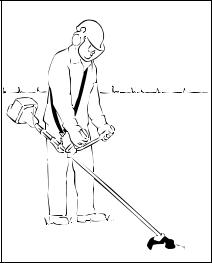
English / USA
!Warning!
Never test the ignition system with ignition wire boot removed from spark plug or with unseated spark plug, since uncontained sparking may cause a fire.
!Warning!
Do not operate your clearing saw if the muffler is damaged, missing or modified. An improperly maintained muffler will increase the risk of fire and hearing loss. Never touch a hot muffler or burn will result. If your muffler was equipped with a spark-arresting screen to reduce the risk of fire (e.g. in the USA, Canada and Australia), never operate your clearing saw if the screen is missing or damaged. Do not modify or remove any part of the muffler or spark arresting screen. Remember that the risk of forest fires is greater in hot or dry weather.
Keep cutting tool sharp. Tighten all nuts, bolts and screws, except the carburetor adjustment screws, after each use.
Additionally, the daily maintenance schedule for your clearing saw set forth in your STIHL Owner's Manual should be strictly followed.
For any maintenance please refer to the maintenance chart and to the warranty statement near the end of this manual.
Store clearing saw in a dry, high or locked location out of reach of children.
Before storing for longer than a few days, always empty the fuel tank. See chapter "Storing the machine".






 002BA018 LÄ
002BA018 LÄ
USING THE CUTTING TOOLS
For an illustration of the various cutting tools and instructions on proper mounting see the chapter "Mounting the cutting tools" in your owner's manual.
Using the mowing heads
Do not use with mowing line longer than the intended diameter. With a properly mounted guard, the built-in cutter will automatically adjust the line to its proper length. Overly long lines can overload the engine, resulting in damage to the clutch mechanism and nearby parts.
FS 500, FS 550 |
13 |
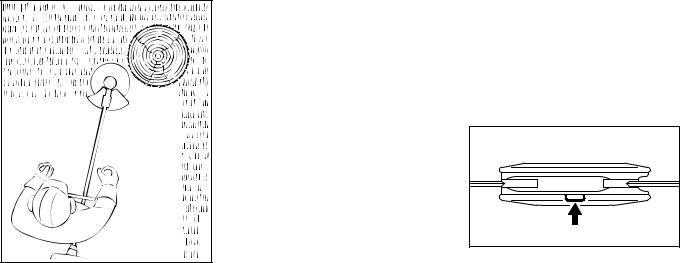
English / USA
000BA015 KN |
A damaged clutch may cause a cutting attachment to rotate at idle speed and increase the risk of personal injury from loss of control and from contact with the cutting tool.
The STIHL SuperCut, TrimCut, AutoCut and PolyCut mowing heads produce a clean and tidy finish.
They are to be used only on brushcutters equipped with a limiter blade in the deflector in order to keep the line at the proper length (see "Parts and Controls" chapter of this manual).
If the lawn edges are planted with trees or bordered by a fence etc., it is best to use a nylon line head. It achieves a "softer" cut with less risk of damaging tree bark etc. than with the polymer blades.
However, the polymer bladed STIHL "PolyCut" produces a better cut if there are no plants along the edge of the lawn. Sharpening is not necessary and worn grass cutting blades are easily replaced.
!Warning!
To reduce the risk of serious injury, never use wire or metal-reinforced line or other material in place of the nylon cutting lines. Pieces of wire could break off and be thrown at high speed toward the operator or bystanders.
STIHL "SuperCut" mowing head
Fresh line is advanced automatically. Frayed line is replaced by a simple adjustment (see instruction sheet supplied with mowing head).
STIHL "TrimCut" mowing head
Frayed line is replaced by a simple adjustment (see instruction sheet supplied with mowing head).
STIHL "AutoCut" mowing head
Nylon cutting cord advances automatically when tapped against the ground.
STIHL "PolyCut" mowing head
Uses either nylon lines or nonrigid plastic blades.
002BA177 KN |
Important! |
Three rectangular wear limit marks are applied to the base (periphery) of the PolyCut. To reduce the risk of serious injury from breakage of the head or blades, the PolyCut must not be used when it has worn as far as one of these marks. It is important to follow the maintenance instructions supplied with the head!
14 |
FS 500, FS 550 |
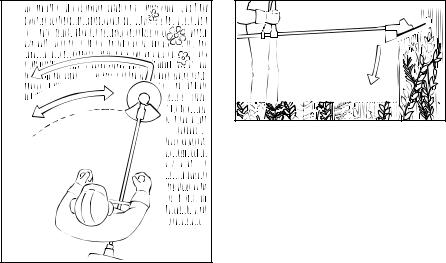
English / USA







 000BA020 KN
000BA020 KN
Using the grass cutting blade
All kinds of grass and weeds can be easily cut with the grass cutting blade. The clearing saw is swept in an arc similar to a scythe.
!Warning!
To reduce the risk of serious or fatal injury never attempt to cut woody materials.
The 4-tooth grass cutting blade is intended to cut grass and weeds. It has 4 cutting knives with cutting edges on both sides, i.e. front and rear.
002BA066 KN |
The 8-tooth grass cutting blade is recommended for cutting fern or reed.
Both blades have to be resharpened when all cutting edges are dull.
Using the brush knife
When fitted to the clearing saw, the brush knife is suitable for applications ranging from cutting matted grass to clearing weeds, wild growth and scrub.
To cut wild growth and scrub, lower the rotating brush knife down onto the growth to achieve a chopping effect. Use the clearing saw like a scythe to cut grass, i.e. sweep it to and for in an arc.
!Warning!
When cutting woody materials, use the left side of the blade to avoid "kickout" (blade thrust) situations.
!Warning!
Improper use of a brush knife may cause it to crack, chip or shatter.
Thrown parts may seriously injure the operator or bystanders. To reduce the risk of personal injury it is essential to take the following precautions:
Avoid contact with hard or solid foreign objects such as stones, rocks or pieces of metal.
Never cut wood or shrubs with a stem diameter of more than 2 cm (3/4") – use a circular saw blade for such work. Inspect the brush knife at regular short intervals for signs of damage. Do not continue working with a damaged brush knife. Resharpen the brush knife regularly (when it has dulled noticeably).
!Warning!
When cutting young saplings or other woody materials up to 2 cm (3/4") in diameter, use left side of the blade to avoid "kickout" situations (see appropriate section in this manual). Do not attempt to cut woody material with a larger diameter, since the blade may catch or jerk the clearing saw forward. This may cause damage to the blade or clearing saw or loss of control of the clearing saw, resulting in personal injury.
FS 500, FS 550 |
15 |
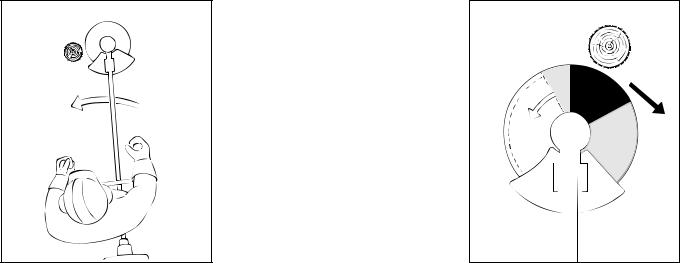
English / USA
000BA016 KN
Using the circular saw blade
Circular saw blades are suitable for thinning brush and cutting small trees up to a diameter of 7 cm (2 3/4"). Do not attempt to cut trees with larger diameters, since the blade may catch or jerk the clearing saw forward. This may cause damage to the blade or loss of control of the clearing saw which may result in serious injury.
When the clearing saw with circular saw blade is used to cut down small trees, STIHL recommends that the standard deflector be removed and replaced by the special "stop" (see chapter "circular saw blade" for mounting instructions). This stop helps to keep the clearing saw positioned against the tree during the cutting process. Inexperienced users should place the left side of the stop against the tree trunk before beginning to cut. This will keep the clearing saw against the tree during the cutting operation and will reduce the risk of loss of control and possible kickout (described in the following section).
!Warning!
In order to reduce the risk of injury from thrown objects or from operator contact with the cutting tool, be sure to remount the standard deflector for all other uses.
Before starting the cut, accelerate the engine up to full throttle. Perform cut with uniform pressure. STIHL recommends that the circular saw blade be applied to the right of the tree, using the non-shaded area of the blade.
000BA012 KN
!Warning!
The risk of kickout is highest when cutting in the darker shaded area. To reduce the risk of kickout and resulting injury, do not use this area of the circular saw blade for cutting trees or shrubs. Special techniques using the lighter shaded areas of the blade to cut shrubs and trees should only be used by experienced operators with specialized training in use and control of the clearing saw.
16 |
FS 500, FS 550 |
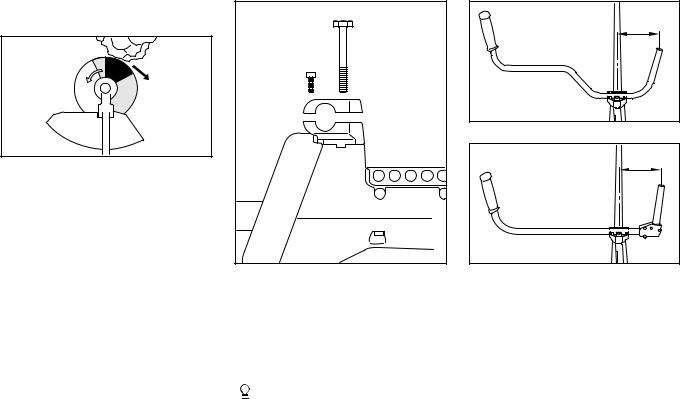
English / USA
Mounting the Bike Handle
Risk of "kickout" (blade thrust) with all rigid cutting blades
002BA135 KN
!Warning!
Kickout (blade thrust) is the sudden and uncontrolled motion towards the operator's right or rear that can occur when the shaded area of the rotating blade comes in contact with a solid object like a tree, rock, bush or wall. The rapid counterclockwise rotation of the blade may be stopped or slowed, and the cutting attachment may be thrown in an area to the right or to the rear.
This kickout (blade thrust) may cause loss of control of the clearing saw and may result in serious or fatal injury to the operator or bystanders. To reduce the risk of injury, extreme caution should be used when cutting with the shaded area of any rigid blade.
3 |
2 |
4 |
1 |
398BA001 KN |
:Hold lower clamp (1) steady.
:Unscrew and remove the clamp screw (2) and the hex. head screw (3).
:Remove the upper clamp (4) from the lower clamp.


 Upper and lower clamps are loose once the hex. head screw has been removed.
Upper and lower clamps are loose once the hex. head screw has been removed.
|
A |
5 |
398BA002 KN |
1 |
A
5 |
|
KN |
|
398BA003 |
|
|
1 |
|
|
|
:Place the handlebar (5) in the lower clamp (1) so that distance A is no more than 6 in (15 cm).
:Place upper clamp in position and press it down.
:Fit the clamp screw and hex. head screw.
:Line up handlebar at right angles to the drive tube.
:Tighten the clamp screw first, then the hex. head screw.
FS 500, FS 550 |
17 |
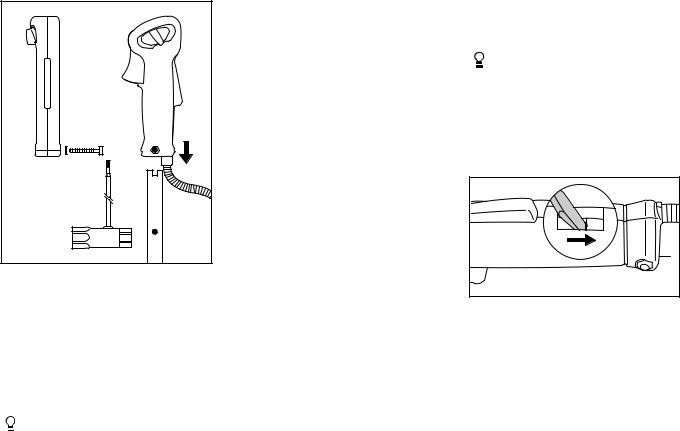
English / USA
Adjusting the Throttle Cable
7 |
7 |
|
|
6 |
|
|
8 |
|
|
|
KN |
|
9 |
398BA004 |
|
|
Throttle Cable Adjustment*
On control handles with slide*:
:Go to chapter "Adjusting the Throttle Cable".
:Loosen the screw (6) and remove it with the washer.
:Push the control handle (7) – throttle trigger must face gearhead – on to the handlebar (8) so that the holes (9) line up.
:Insert screw with washer and tighten it down firmly.


 To save space when transporting or storing the machine, loosen the clamp screw and hex. head screw and swing the handlebar in line with the shaft, fold the handles down.
To save space when transporting or storing the machine, loosen the clamp screw and hex. head screw and swing the handlebar in line with the shaft, fold the handles down.
* see "Guide to Using this Manual"
Some machine versions are equipped with a throttle cable adjuster in the control handle.


 A properly adjusted throttle cable is the precondition for correct operation in the full throttle, starting throttle and idle positions.
A properly adjusted throttle cable is the precondition for correct operation in the full throttle, starting throttle and idle positions.
Adjust the throttle cable only after the unit is fully assembled – the control handle must be in the normal operating position.
002BA163 KN
:Use a suitable tool to push the slide to the bottom of the slot (see illustration).
18 |
FS 500, FS 550 |
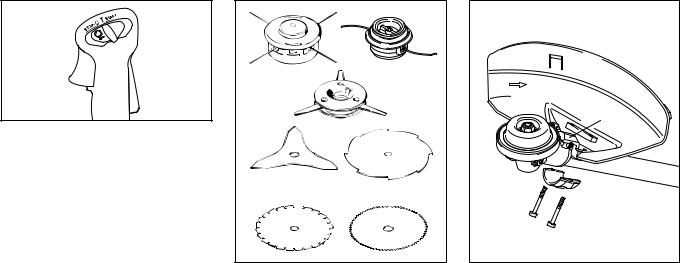
English / USA
Approved Combinations of
Cutting Tool and Deflector
STOP |
|
1 |
2 |
2 |
|
|
|
|
KN |
|
3 |
1 |
249BA017 |
|
|
|
|
||
|
|
|
|
|
|
4+5 |
6 |
: Press down the trigger interlock (1) |
|
|
|
and squeeze the throttle trigger (2) |
|
|
|
(full throttle) – this sets the throttle |
|
|
|
cable correctly. |
|
7+8 |
9+10 |
|
|
||
|
|
|
398BA046 KN |
|
Approved Cutting Tools |
||
|
1 |
STIHL AutoCut 40-4 |
|
|
2 |
STIHL TrimCut 50-2 |
|
|
3 |
STIHL PolyCut 40-3 |
|
|
4 |
Brush knife 350-3 |
|
|
5 |
Brush knife 350-3 "Special" |
|
|
6 |
Grass cutting blade 255-8 |
|
|
7 |
Circular saw blade 225 |
|
|
|
(chisel tooth) |
|
|
8 |
Circular saw blade 225 |
|
|
|
(carbide tipped) |
|
|
9 |
Circular saw blade 225 |
|
|
|
(scratcher tooth) |
|
|
10 |
Circular saw blade 250 |
|
|
|
(scratcher tooth) |
|
11 |
12 |
14 |
13 |
398BA048 KN |
Deflector and Stops
11 Deflector for cutting tools 1 to 6
Mounting the deflector
:Place deflector on the gearhead so that the molding (12) locates around the neck of the gearhead.
:Fit the clamp (13).
:Insert screws and tighten them down firmly.
The grass shield (14) is used in conjunction with some mowing tools.
FS 500, FS 550 |
19 |
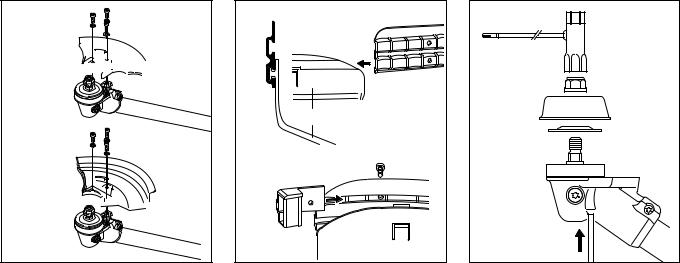
English / USA
Mounting the Cutting Tools
 15
15

 16
16
398BA049 KN
15Limit stop for circular saw blades 225
16Limit stop for circular saw blades 250
Mounting the stop
:First remove the grass shield (if fitted).
:Place limit stop 15 or 16 in position.
:Insert the screws and tighten them down firmly.
17
20
18
11
19
398BA044 KN
:If you use one of the mowing heads, note that the skirt (17) must be attached to the deflector (11).
:Use lower guide slot (18) for mowing heads 1 and 2. Push the blade (19) into the upper guide slot and line it up with the hole.
:Fit the screw and tighten it down firmly.
:Use the skirt’s upper guide slot (20) for mowing head 3.
3 |
|
4 |
|
5 |
|
6 |
|
2 |
|
|
KN |
1 |
398BA051 |
|
Blocking the Drive Shaft
:Insert the stop pin (1) in the bore (2) in the gearhead as far as stop, apply slight pressure.
:Rotate the output shaft until the stop pin slips into position.
:Use combination wrench (3) to loosen and unscrew the nut (4) clockwise.
:Remove the rider plate (5) and thrust washer (6).
20 |
FS 500, FS 550 |
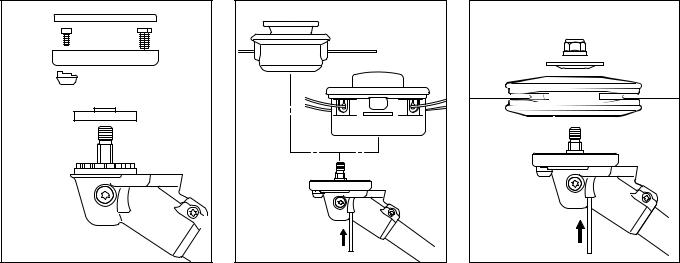
English / USA
 A
A 

398BA052 KN
Grass Shield*
:The grass shield may only be used together with the 2.4 in (60 mm) diameter thrust plate (A) and the deflector for mowing heads.
*see "Guide to Using this Manual"
7 |
398BA053 KN |
STIHL AutoCut
STIHL TrimCut
:Block the output shaft with the stop pin.
:Screw cutting head counterclockwise onto the output shaft (7) and
Important: Remove the stop pin.
Removing the mowing head
:Block the output shaft.
:Unscrew the mowing head clockwise.
4 |
6 |
398BA054 KN |
STIHL PolyCut 40-3 |
:Block the output shaft with the stop pin.
:Position the mowing head on the shaft.
:Fit the 2.4 in (60 mm) diameter thrust washer (6) –
convex side must face down.
:Screw on nut (4) counterclockwise and tighten down firmly. Important: Remove the stop pin.
Removing the mowing head
:Block the output shaft.
:Unscrew the nut clockwise.
If the mounting nut is too loose (cannot be tightened properly), fit a new one.
FS 500, FS 550 |
21 |
English / USA
Adjusting Nylon Line
Note
A detailed description is contained in the instruction sheet supplied with the mowing head.
STIHL AutoCut
Hold the rotating mowing head above the ground.
:Tap the mowing head on the ground
– fresh line is advanced and the blade on the deflector trims surplus line to the correct length.
Line feed operates only if both lines are still at least 1 in (2.5 cm) long.
STIHL TrimCut
Shut off the engine and move the slide control to 0. Hold mowing head housing firmly and
:Pull spool up – rotate it about 1/6 turn counterclockwise and allow it to spring back.
:Pull ends of lines outward.
Repeat the above procedure as necessary until both lines are 5.5 in (14 cm) long.
Rotating the spool from one stop to the next advances about 1.6 in (4 cm) of fresh line.
22 |
FS 500, FS 550 |
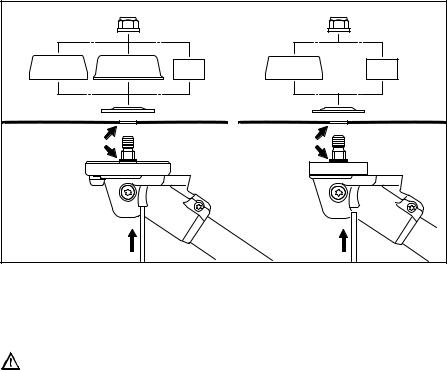
English / USA
Fuel
|
|
4 |
|
4 |
3 |
3 |
3 |
5 |
5 |
2 |
|
1 |
2 |
1 |
|
|
|
|
398BA050 KN |
Grass cutting blade 255-8 Brush knife 350-3
Brush knife 350-3 "Special"
:Place the cutting tool (1) in position.
Collar (see arrow) must engage the cutting tool’s mounting hole.
Cutting edges on grass cutting blade 255-8 and the circular saw blades must point clockwise.
:Fit thrust washer (2) – convex side must face up.
For mowing:
:Fit rider plate (3) for mowing.
Circular saw blades 225
Circular saw blade 230
Circular saw blade 250
For sawing:
:Fit rider plate (5) for sawing.
:Block the output shaft.
:Screw on nut (4) counterclockwise and tighten down firmly.
Removing the cutting tool
:Block the output shaft.
:Unscrew the nut clockwise.
If the mounting nut is too loose (cannot be tightened properly), fit a new one.
This engine is certified to operate on unleaded gasoline and the STIHL twostroke engine oil at a mix ratio of 50:1.
Your engine requires a mixture of highquality gasoline and quality two-stroke air cooled engine oil.
Use mid-grade unleaded gasoline with a minimum octane rating of 89 (R+M/2). If the octane rating of the mid-grade gasoline in your area is lower, use premium unleaded fuel.
Fuel with a lower octane rating may increase engine temperatures. This, in turn, increases the risk of piston seizure and damage to the engine.
The chemical composition of the fuel is also important. Some fuel additives not only detrimentally affect elastomers (carburetor diaphragms, oil seals, fuel lines, etc.), but magnesium castings and catalytic converters as well. This could cause running problems or even damage the engine. For this reason STIHL recommends that you use only nationally recognized high-quality unleaded gasoline!
FS 500, FS 550 |
23 |
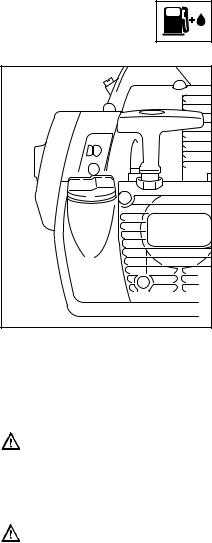
English / USA
Use only STIHL two-stroke engine oil or equivalent high-quality two-stroke engine oils that are designed for use only in air cooled two-cycle engines.
We recommend STIHL 50:1 two-stroke engine oil since it is specially formulated for use in STlHL engines.
Do not use BIA or TCW rated (twostroke water cooled) mix oils or other mix oils that state they are for use in both water cooled and air cooled engines (e.g., outboard motors, snowmobiles, chainsaws, mopeds, etc.).
Take care when handling gasoline. Avoid direct contact with the skin and avoid inhaling fuel vapor. When filling at the pump, first remove the canister from your vehicle and place the canister on the ground before filling. Do not fill fuel canisters that are sitting in or on a vehicle.
The canister should be kept tightly closed in order to avoid any moisture getting into the mixture.
The machine‘s fuel tank and the canister in which fuel mix is stored should be cleaned as necessary.
Fuel mix ages
Only mix sufficient fuel for a few days work, not to exceed 3 months of storage. Store in approved fuel-canisters only. When mixing, pour oil into the canister first, and then add gasoline. Close the canister and shake it vigorously by hand to ensure proper mixing of the oil with the fuel.
Gaso- |
Oil (STIHL 50:1 or |
line |
equivalent high-quality oils) |
US gal. |
US fl.oz |
1 |
2.6 |
2 1/2 |
6.4 |
5 |
12.8 |
Dispose of empty mixing-oil canisters only at authorized disposal locations.
Fueling
398BA014 KN
Before fueling, clean the filler cap and the area around it to ensure that no dirt falls into the tank.
Always thoroughly shake the mixture in the can before fueling your machine.
In order to reduce the risk of burns or other personal injury from
escaping gas vapor and fumes, remove the fuel filler cap carefully so as to allow any pressure build-up in the tank to release slowly.
After fueling, tighten down the filler cap by hand as securely as possible.
24 |
FS 500, FS 550 |

|
|
|
|
|
English / USA |
|
|
|
|
|
Fitting the Harness |
|
|
|
: |
Push grommet home and check that |
|
|
|
|
|
it is properly seated. |
|
|
|
|
: Fit the carburetor box cover. |
1 |
|
|
|
|
|
|
|
A |
|
|
|
|
|
|
|
|
|
|
2 |
|
|
|
398BA015KN |
|
3 |
3 |
2 |
1 |
|
002BA240KN |
|
|
|
|
|||
Change the fuel pickup body once every year
:Drain the fuel tank.
:Set the choke knob to g.
:Remove carburetor box cover (1).
:Pry grommet (2) with fuel hose out of the tank.
:Remove the fuel pickup body (3).
:Push new pickup body into the hose and place it in the tank. The distance between the bottom of the grommet and the stop of the pickup body is A = 1.6 in (40 mm).
:Put on the full harness (1).
:Adjust length until the spring hook (2) is about a hand’s width below your right hip. Over-long straps can be cut to length after making the adjustments.
:Attach the spring hook to the machine’s perforated strip (3).
Find the right attachment point for the cutting tool you are using – see section "Balancing the Machine".
FS 500, FS 550 |
25 |
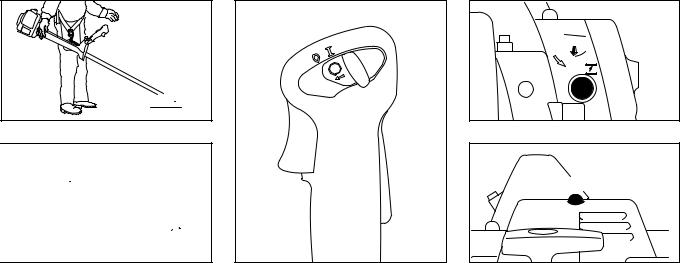
English / USA |
|
Balancing the Machine |
Starting / Stopping the |
|
Engine |

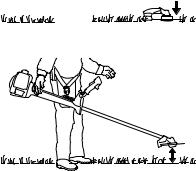 256BA017 KN 256BA016 KN
256BA017 KN 256BA016 KN
:Attach machine to the harness. Let it go and check to see how it is balanced – change the attachment point of the spring hook as necessary:
Mowing tools (mowing heads, grass cutting blades, brush knives, Shredder blades) should just touch the ground (top illustration).
Circular saw blades should "hover" about 20 cm (8 in) above the ground (bottom illustration).
START
3 STOP
2
1
256BA018 KN
:Observe safety precautions – see chapter "Safety Precautions and working techniques" in this manual.
:Hold down the throttle trigger interlock (1) and squeeze the throttle trigger (2).
:While holding both levers in this position, move slide control (3) to START and hold it there.
:Now release the throttle trigger, slide control and trigger interlock in that order. This is the starting
throttle position.
 4
4
|
KN |
5 |
398BA016 |
|
6 |
398BA017 KN |
:Set the choke knob (4):
For cold start, turn counterclockwise to g.
For warm start, turn clockwise away from g(also use this setting if engine has been running but is still cold).
:Press the fuel pump bulb (5) at least five times – even if the bulb is filled with fuel.
:Press the decompression valve button (6). Press this button before each starting attempt.
26 |
FS 500, FS 550 |
